Mai Nhat Linh1, Le Vinh Thuc1, Jun-Ichi Sakagami2, Susan Orgill3, Tran Huu Van4, Nguyen Quoc Khuong1, Pham Phuoc Nhan1
1College of Agriculture, Can Tho University, Viet Nam
2Tropical Crop Science Laboratory, Faculty of Agriculture, Kagoshima University, Japan
3Wagga Wagga Agricultural Institute, NSW Department of Primary Industries, Australia
4Master Student Course 25 of Crop Science, Can Tho University, Viet Nam
Correspondence to: Le Vinh Thuc, College of Agriculture, Can Tho University, Viet Nam.
| Email: |  |
Copyright © 2021 The Author(s). Published by Scientific & Academic Publishing.
This work is licensed under the Creative Commons Attribution International License (CC BY).
http://creativecommons.org/licenses/by/4.0/

Abstract
Intermittent or persistent waterlogging is a challenge for crop selection and rotation on rice growing soils. The pot experiment was carried out in a randomized complete block design including five treatments and eight replications in the controlled nethouse. The five treatments are five sesame varieties (VTH, DTH, M6 and LV which are commonly planted in Mekong River Delta and ADB1 is a sesame variety from Institute of Agricultural Science for South Viet Nam). This research evaluated these sesame varieties for their resistance to waterlogging. All the sesame varieties at flowering stage were flooded with 5 centimeters of river water ponded above the soil surface. There was a significant (P<0.05) impact of waterlogging on all plant growth parameters, including: plant height, number of leaves per plant, number of flowers per plant, number of pods per fruit, root length, total biomass and the amount of oxygen content exchanged through the leaf (photosynthetic rate). The sesame variety ADB1 had significantly (P<0.05) and consistently higher values for all plant growth parameters as well as establishment of adventitious roots. Therefore, it is recommended that ADB1 is selected and cultivated where waterlogging may occur.
Keywords:
Sesame variety, Waterlogging, Sesamum indicum L.
Cite this paper: Mai Nhat Linh, Le Vinh Thuc, Jun-Ichi Sakagami, Susan Orgill, Tran Huu Van, Nguyen Quoc Khuong, Pham Phuoc Nhan, Effects of Waterlogging on the Growth of Different Varieties of Sesame (Sesamum indicum L.), International Journal of Plant Research, Vol. 11 No. 1, 2021, pp. 1-6. doi: 10.5923/j.plant.20211101.01.
1. Introduction
Sesame (Sesamum indicum L.) is an annual crop, has high oil content, delicious nutty aroma, flavor and is traditionally categorized as a health food in Asian countries. It is grown in the tropics and subtropics of Asia [1]. Sesame has many characteristics that make it a valuable agricultural crop in modern farming systems, including: drought tolerance, high oil content, short growing season and a large propagation coefficient [2]. Sesame seeds also contain a vast array of phenolic compounds that display strong antioxidant activities [3]. However, sesame is extremely susceptible to waterlogging and continuous heavy rains thus limiting its potential growing range in South East Asia. Compounding this issue is the increasing impact of climate change which is rapidly degrading the resource condition of arable land, resulting in a considerable decline in soil quality, in particular, soil structure leading to increased susceptibility and occurrence of waterlogging [4]. When grown on soils with poor drainage, sesame growth is adversely affected with yield losses of more than 30 %, and in severe cases 50 - 90% yield loss experienced [5,6]. Various physiological attributes of sesame, such as growth rate, biomass, capsule per plant, photosynthesis, chlorophyll content and seed yield are extremely reduced by excess soil water [1]. Waterlogged conditions also lead to low oxygen diffusion rates [7], which cause plants to undergo fermentative metabolism from respiration to maintain metabolism and growth under hypoxic conditions [6]. In Mekong Delta, Viet Nam sesame is selected to grow in rotation with rice during the dry season. Nowadays, several farmers grow sesame in rainy seasons and they face the problems with waterlogging due to raining. The purpose of this study was to evaluate the waterlogging tolerance of different varieties of sesame for growing in rainy season.
2. Materials and Method
Study area and materialsThis evaluation trial was conducted in the nethouse of Crop Science Department at Can Tho University. The five sesame varieties were collected included yellow sesame (VTH) and black sesame (DTH, ADB1, M6 and LV). The VTH, DTH, M6 and LV varieties are commonly planted in Mekong River Delta. ADB1 is a sesame variety from Institute of Agricultural Science for South Viet Nam. Agronomical traits of the five varieties of sesame are listed in Table 1. Table 1. Agronomical traits of five varieties of sesame used in the experiment
 |
| |
|
The physico-chemical analysis of the paddy soil showed the following concentrations: 0.83% organic matter, total nitrogen (N) 0.33 mg/kg dry soil, phosphorous (P) 4.9 mg/kg dry soil, potassium (K) 128 mg/kg dry soil, and calcium (Ca) 101 mg/kg dry soil. It also showed 6.5 pH. The soil was identified as Gleysols according to the WRB classification, with soil textures of sand, silt and clay of 1.40, 39.8 and 58.8, respectively.Experimental designThe pot experiment was carried out in a nethouse with a randomized complete block design including five treatments and eight replications. Each pot contained 0.5 kg of soil. The soil was collected from the surface of paddy field (0-15 cm soil layer) where sesame was planted, then dried under the sunlight for one week and uniformly mixed together. Each pot was planted with 2 sesame plants. All the sesame varieties at flowering stage (Figure 1A) were flooded with 5 centimeters of water ponded above the soil surface (Figure 1B). River water was used for waterlogging the pots.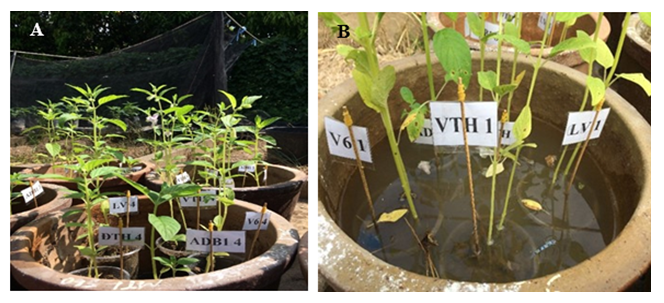 | Figure 1. Sesame plant at flowering stage pre-submergence (A); sesame plants post-submergence (B) |
Data collection methods Measurements included plant height (cm), number of leaves per plant, number of flowers per plant, number of capsules (pods) per plant, fresh and dried biomass (g) and chlorophyll content. The following parameters were measured every seven days; plant height (cm) was measured from the soil surface to the highest peak; number of leaves per plant (leaf) were counted and recorded from the first true to the top leaves. The number of capsules per plant (fruit) were counted at harvest. Total number of seed bearing capsules on each selected plant including those on main stem and primary branches were counted and recorded. The mass (g) of total fresh biomass, stalks and leaves and capsules was recorded immediately after harvest. Total dry biomass; stalks and leaves and dry mass of pods were oven dried at 65°C and weighed to calculate biomass dry weight (g) per plant per pot. Chlorophyll content in leaf (µgChlmg-1) was measured at 0, 2 and 4 days post-submergence according to the N,N-Dimethyl formamide method [8]. Stomatal conductance was determined using a SC-1 Leaf Porometer (Decagon Devices, Pullman, WA, USA) pre- and post-submergence.Statistical analysis The data presented in this paper are mean values of eight replications, unless otherwise stated. All data were analyzed using one-way analysis of variance (ANOVA) in the SPSS software package version 13.0. All mean values were subjected to one-way ANOVA and comparison of means for significant differences was assessed using Duncan’s post-hoc test at P < 0.05.
3. Results
Effects of waterlogging on plant height: There was no significant difference in plant height and the number of leaves per plant between the five sesame varieties during 7 days the pre-submergence period (Figure 2). However, under waterlogged conditions (14 days post-submergence), there was a significant difference (P <0.05) in plant height with sesame variety. Specifically, ADB1 had a significantly greater plant height (47.59 cm) compared with LV (42.42 cm), VTH (40.28 cm), DTH (37.21 cm) and M6 (34.91 cm). After one week of waterlogging, there was no significant increase in plant height for the VTH, DTH, M6 and LV varieties. In contrast, the plant height of ADB1 continued to significantly (P<0.05) increase (Figure 2). | Figure 2. Effects of waterlogging on mean plant height of sesame varieties. Means (± SD, n = 8) with different letters above the bars are significantly different (p < 0.05) according to Duncan's multiple-range test. Means without letters are not significantly different |
Effects of waterlogging on number of leaves per plantThe number of leaves per plant were in gneral reduced after 7 days post-submergence but not significant different among sesame varieties. However, ADB1 variety still occurred new leaves (Figure 3). The number of leaves per plant at 14 days post-submergence was also significantly different (P<0.05) with sesame variety, and ranked from highest to lowest was ADB1, LV, DTH, M6 and VTH (10.3>8.0 ~ 7.6> 5.7> 4.1) respectively (Figure 3). 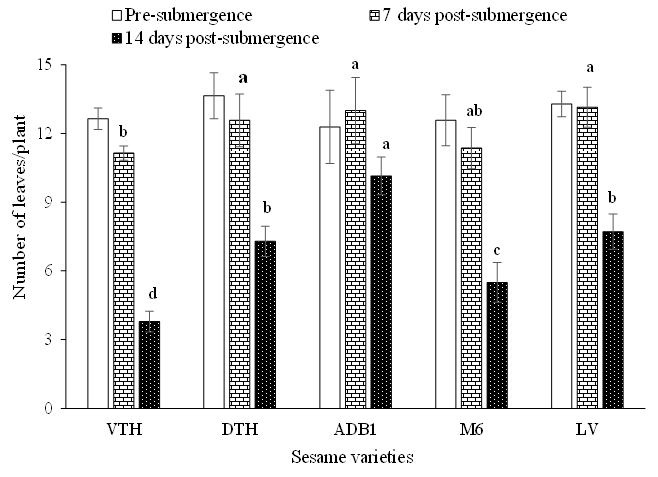 | Figure 3. Effects of waterlogging on mean plant height of sesame. Means (± SD, n = 8) with different letters above the bars are significantly different (p < 0.05) according to Duncan's multiple-range test. Means without letters are not significantly different |
Effects of waterlogging on roots Among these sesame varieties, after 9 days post submergence the ADB1 variety formed adventitious roots in the water (Figure 4). This observation was not appeared in the rest of varieties. 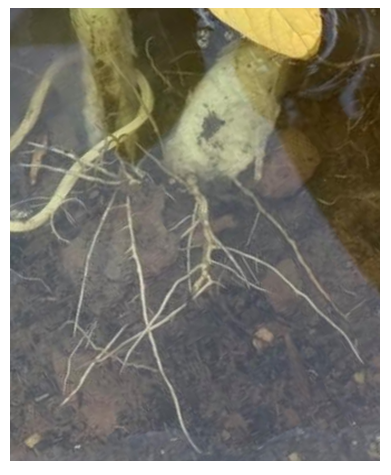 | Figure 4. New root of ADB1 occurance in water after 9 days submergence |
There was also a significant difference in the root damage of sesame variety, with ADB1 having less root demages in compared with the others and occurance of adventitious roots (Figure 5). There were several root damanges occurred in VTH and DTH varieties.  | Figure 5. The roots of five sesame varieties after 14 days submergence |
Effects of waterlogging on biomass There was a significant difference (P<0.05) in fresh and dry total biomass, stalks and pods (Figure 6). ADB1 had the greatest mass (g) of total biomass (fresh; 22.07 and dry; 10.07), stalk (fresh; 14.1 and dry; 7.17) and pods (fresh; 8.02 and dry 3.13) compared with the other sesame varieties. The range in dry mass (g) values for VTH, DTH, M6 and LV were total biomass; 4.79 to 6.61, stalks; 2.57 to 4.97 and pods; 1.48 to 1.86; although these were not statistically different. Most notably, the mean mass of pods (dry; 3.13 g) for ADB1 was approximately double that of the other sesame varieties (Figure 6).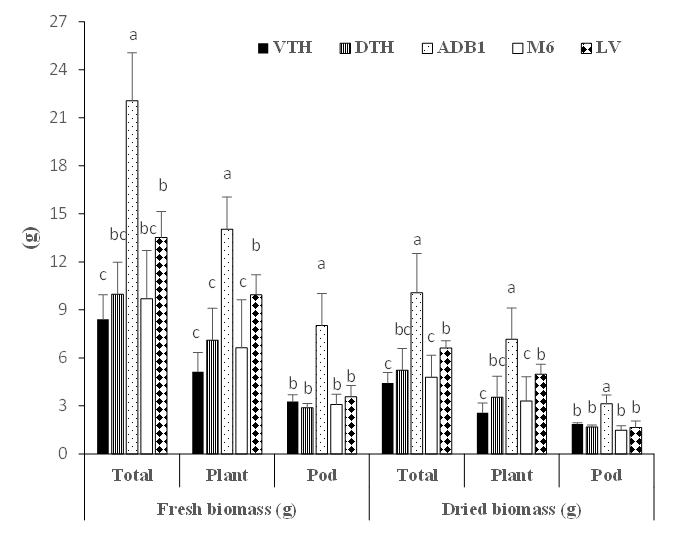 | Figure 6. Effects of waterlogging on the mean of fresh mass and dried biomass of different variety of sesame. Means (± SD, n = 8) with different letters above the bars are significantly different (p < 0.05) according to Duncan's multiple-range test. |
Effects of waterlogging on stomatal conductance and chlorophyll content Under waterlogging conditions, there was a significant difference (P<0.05) in the exchangeable oxygen content of sesame leaves at time zero (0) and in the two periods post-submergence; that is, two and four hours after (Figure 7). In the pre-submergence phase (time zero), the highest exchangeable oxygen content was ADB1 variety (1,649.3 mmol/m2s). At two and four hours post-submergence, the ADB1 variety had a significantly (P<0.05) higher exchangeable oxygen content than all other varieties (between which there was no significant difference) with values at two and four hours of 1,726.3 and 1,284.3 mmol/m2s respectively (Figure 7).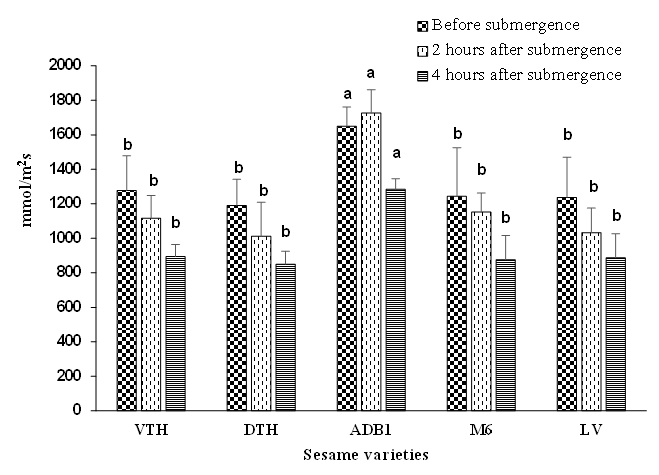 | Figure 7. Effects of waterlogging on mean exchangeable oxygen content of leaves (photosynthesis; mmol/m2s). Means (± SD, n = 8) with different letters above the bars are significantly different (p < 0.05) according to Duncan's multiple-range test |
The results in Figure 8 indicated that total chlorophyll reduced during waterlogging. There was a similar trend with total chlorophyll content in leaves, with ADB1 having a significantly (P<0.05) higher value at pre-submergence and two and seven days post-submergence; 14.68, 12.58 and 11.05 µgChlmg-1 respectively (Figure 8).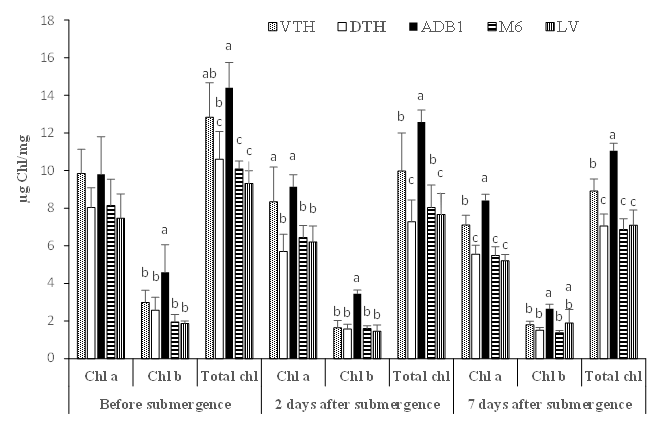 | Figure 8. Effects of waterlogging on mean chlorophyll (µgChlmg-1) content. Means (± SD, n = 8) with different letters above the bars are significantly different (p < 0.05) according to Duncan's multiple-range test. Means without letters are not significantly different |
Effects of waterlogging on the number of capsules per plant: There was also a significant difference (P<0.05) in the number of pods per plant with sesame variety, with ADB1 having the highest values (Figure 9). Sesame varieties LV, VTH, DTH and M6 recorded mean values of number of pods per plant of 3.6, 3.3, 3.1 and 4.0 respectively (Figure 9).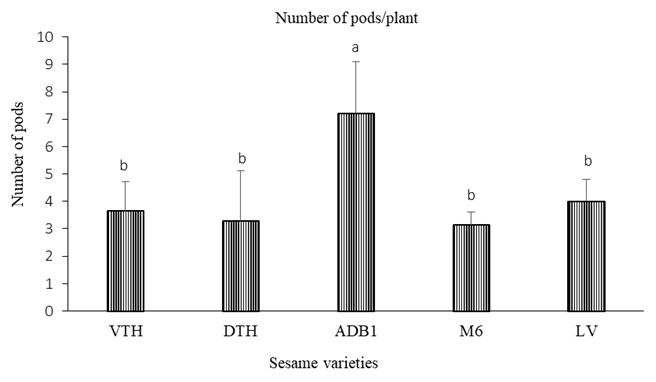 | Figure 9. Number of pods per plant of five sesame varieties after 14 days submergence. Means (± SD, n = 8) with different letters above the bars are significantly different (p < 0.05) according to Duncan's multiple-range test. Means without letters are not significantly different |
4. Discussion
Our results indicate that waterlogging at the productive stage is detrimental to sesame plant growth. Our findings support those of Saha et al. [9] who reported that overall plant growth, including plant height, root volume, root length, leaf area and root dry weight per plant in four sesame genotypes significantly decreased due to the effects of waterlogging. However, the severity and yield penalty of waterlogging stress in sesame plants depends upon the crop stage, duration of waterlogging, soil type (including structure), growth conditions, and genotype [10]. In general, it seems that waterlogging (24 hours) at early, vegetative, and flowering stages has more detrimental effect on yield compared to waterlogging at pod formation stage [11]. In waterlogging condition, ADB1 sesame variety established new roots in the water (Figure 4). This observation was simlar to the research from Wei et al. [12] on ZZM2541 sesame variety which is a waterlogging tolerance variety. According to Gomathi et al. [13], waterlogging tolerant plants could able to survive through formation of adaptive traits like aerial roots which are temporary source of oxygen for the respiratory event. Water-induced plant stress affects stomatal response, rate of metabolic changes, radical scavenging, and the photosynthetic rate of plants; ultimately constraining plant growth [14,15]. According to Xu and Zhou [16] excess water in soil can also result in a drastic reduction of photosynthesis, as well as stomatal conductance. Importantly, photosynthetic pigments are reported to be more affected with continued waterlogging [17]. However, waterlogged conditions even for a very short period of time can adversely effect plant physiology resulting in a significant reduction in plant growth and crop yield [15]. According to Poljakoff and Gale [18], the ability to synthesize more chlorophyll under water stress is a good measure of the species tolerance to drought. However, in our study the chlorophyll content of the leaves under flooded conditions was significantly (P<0.05) reduced. Furthermore, it has been observed that under flooding, the leaves of sesame plants turn yellow, senescence early and are shed, with abscission occurring in older basal leaves and subsequently in younger upper leaves. This is consistent with our observations, and explains why varieties VTH, DTH, M6 and LV obtained the lower chlorophyll content than variety ADB1. Based on reported chlorophyll content under both drought and flooding conditions [19], it could be inferred from the present study that sesame may be drought resistant but the selection of the variety needs careful consideration if it needs to withstand flooding and waterlogged soil conditions. Genotypic sensitivity to waterlogging is another important factor to consider. This sensitivity may be related to the level of endogenous plant hormones which increase dropping of flowers and/or the loss of capsules setting, as also observed in soybean plant [20] and snap bean plant [21].
5. Conclusions
Waterlogging caused by soil structural decline, high amounts of in-crop rainfall, previous rice crops or a combination of all three has limited the incorporation of sesame rotations in rice systems in Vietnam. This study evaluated waterlogging tolerance of five sesame varieties and identified ADB1 as the superior variety based on plant growth and yield parameters. Importantly, ADB1 also performed well under non-waterlogged conditions indicating its suitability for seasonally waterlogged soils. More research is required on the time of sowing and tactical agronomy to optimize the yield and profitability of sesame crops.
ACKNOWLEDGEMENTS
This project was funded by the Upgrading Project of Can Tho University VN14-P6 with ODA loans from the Japanese Government.
SIGNIFICANCE STATEMENT
This study discovered ADB1 sesame variety can be a candidate for waterlogging tolerance sesame variety. This study will help the farmers in Mekong Delta, Viet Nam to determine which sesame variety to grow in rainy season to reduce the effect of waterlogging due to heavy raining.
References
| [1] | Myint, D., S.A. Gilani, M. Kawase and K.N. Watanabe, 2020. Sustainable sesame (Sesamum indicum L.) production through improved technology: an overview of production, challenges, and opportunities in Myanmar. Sustain., 12: 3515. |
| [2] | Wei, X., H. Gong, J. Yu, P. Liu, L. Wang, Y. Zhang and X. Zhang, 2017. Sesame FG: an integrated database for the functional genomics of sesame. Sci. Rep., 7: 2342. |
| [3] | Bodoira, R., A. Velez, A.E. Andreatta, M. MartA-nez and D. Maestri, 2017. Extraction of bioactive compounds from sesame (Sesamum indicum L.) defatted seeds using water and ethanol under sub-critical conditions. Food Chem., 237: 114-120. |
| [4] | Fan, M., J. Shen, L. Yuan, R. Jiang, X. Chen, W.J. Davies and F. Zhang, 2011. Improving crop productivity and resource use efficiency to ensure food security and environmental quality in China. J. Exp. Bot., 63: 13-24. |
| [5] | Snowden, R. and B.D. Wheeler, 1993. Iron toxicity to fen plant species. J. Ecol., 81(1): 35-46. |
| [6] | Wang, L., Y. Zhang, X. Qi, D. Li, W. Wei and X. Zhang, 2012. Global gene expression responses to waterlogging in roots of sesame (Sesamum indicum L.). Acta Physiol. Plant., 34: 2241-2249. |
| [7] | Christianson, J.A., D.J. Llewellyn, E.S. Dennis and I.W. Wilson, 2009. Global gene expression responses to waterlogging in roots and leaves of cotton (Gossypium hirsutum L.). Plant Cell Physiol., 51: 21-37. |
| [8] | Moran, R., 1982. Formulae for determination of chlorophyllous pigments extracted with N,N-Dimethyl formamide. Plant Physiol., 69(6): 1376–1381. |
| [9] | Saha, R.R., F. Ahmed, N. Mokarroma, M.M. Rohman and P.C. Golder, 2016. Physiological and biochemical changes in waterlog tolerant sesame genotypes. SAARC J. Agric., 14, 31-45. |
| [10] | Sarkar, P.K., A. Khatun and A. Singha, 2016. Effect of duration of water-logging on crop stand and yield of sesame. Int., J. Innov. Appl. Stud., 14: 1-6. http://www.ijias.issr-journals.org/. |
| [11] | Ali, M.H., 2018. Effect of Different durations of water-loggings at different growth stages on seed yield of sesame. Int. J. Appl. Sci., 1(2): 2576-7259. |
| [12] | Wei, W., D. Li, L. Wang, X. Ding, Y. Zhang, Y. Gao and X. Zhang, 2013. Morpho-anatomical and physiological responses to waterlogging of sesame (Sesamum indicum L.). Plant Sci., 208: 102-111. |
| [13] | Gomathi, R., P.N. Gururaja Rao, K. Chandran and A. Selvi, 2014. Adaptive responses of sugarcane to waterlogging stress: An over view. Sugar Tech. Doi 10.1007/s12355-014-0319-0. |
| [14] | Boru, G., M.V. Ginkel, W.E. Kronstad and L. Boersma, 2001. Expression and inheritance of waterlogging tolerance stress in wheat. Euphytica, 117: 91–98. |
| [15] | Osakabe, Y., K. Osakabe, K. Shinozaki and L.S.P. Tran, 2014. Response of plants to water stress. Front. Plant Sci., 5: 1-8. |
| [16] | Xu, Z. and G. Zhou, G., 2011. Responses of photosynthetic capacity to soil moisture gradient in perennial rhizome grass and perennial bunch grass. BMC Plant Biol., 11:21. https://www.biomedcentral.com/articles/10.1186/1471-2229-11-21. |
| [17] | Setter, T.L. and I. Waters, 2003. Review of prospects for germplasm improvement for waterlogging tolerance in wheat barley and oats., Plant Soil, 253: 1-34. |
| [18] | Poljakoff, M. and J. Gale, 1975. Plants in Saline environments. Springer Verlag, Belin. https://link.springer.com/book/10.1007/978-3-642-80929-3. |
| [19] | Mensah, J.K., B.O. Obadoni, P.G. Eruotor and F. Onome-Irieguna, 2006. Simulated flooding and drought effects on germination, growth, and yield parameters of sesame (Sesamum indicum L.). Afr. J. Biotechnol., 5: 1249-1253. https://www.ajol.info/index.php/ajb/article/view/43092. |
| [20] | Ara, R., M.A. Mannan, Q.A. Khaliq and M.M. Uddin Miah, 2015. Waterlogging tolerance of soybean. Bangladesh Agro. J., 18(2): 105-109. |
| [21] | Lakitan, B., D.B. Wolfe, R.W. Zobel, 1992. Flooding affects snap bean yield and genotypic variation in leaf gas exchange and root growth response. J. Amer. Soc. Hort. Sci., 117: 711–716. |






 Abstract
Abstract Reference
Reference Full-Text PDF
Full-Text PDF Full-text HTML
Full-text HTML





